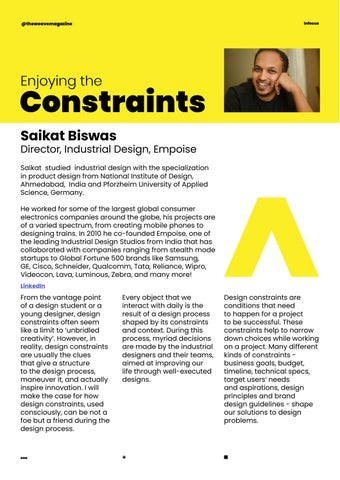@theweavemagazine
Infocus
Enjoying the
Constraints Saikat Biswas
Director, Industrial Design, Empoise Saikat studied industrial design with the specialization in product design from National Institute of Design, Ahmedabad, India and Pforzheim University of Applied Science, Germany. He worked for some of the largest global consumer electronics companies around the globe, his projects are of a varied spectrum, from creating mobile phones to designing trains. In 2010 he co-founded Empoise, one of the leading Industrial Design Studios from India that has collaborated with companies ranging from stealth mode startups to Global Fortune 500 brands like Samsung, GE, Cisco, Schneider, Qualcomm, Tata, Reliance, Wipro, Videocon, Lava, Luminous, Zebra, and many more! LinkedIn
From the vantage point of a design student or a young designer, design constraints often seem like a limit to ‘unbridled creativity’. However, in reality, design constraints are usually the clues that give a structure to the design process, maneuver it, and actually inspire innovation. I will make the case for how design constraints, used consciously, can be not a foe but a friend during the design process.
Every object that we interact with daily is the result of a design process shaped by its constraints and context. During this process, myriad decisions are made by the industrial designers and their teams, aimed at improving our life through well-executed designs.
Design constraints are conditions that need to happen for a project to be successful. These constraints help to narrow down choices while working on a project. Many different kinds of constraints business goals, budget, timeline, technical specs, target users’ needs and aspirations, design principles and brand design guidelines - shape our solutions to design problems.
